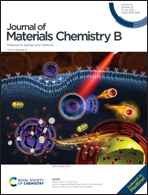AuNCs–LHRHa nano-system for FL/CT dual-mode imaging and photothermal therapy of targeted prostate cancer†
Abstract
As the most common cancer in men worldwide, prostate cancer has a serious impact on people's health. Until now, the development of a platform for integrating tumor targeting, imaging and an effective treatment for prostate cancer has remained challenging. Herein, a nano-system is designed to improve both diagnosis and treatment for prostate cancer. We successfully synthesized an AuNCs–LHRHa nano-system by combining PEI-modified gold nanoclusters (AuNCs) with LHRH analogues (LHRHa). Due to the good tunable optical properties and photothermal properties of AuNCs, the nano-system can not only achieve efficient fluorescence/computed tomography dual-mode imaging, but can also be used for photothermal therapy (PTT). After modifying the LHRHa antibody of a prostate tumor, AuNCs–LHRHa can be more effectively recognized by the gonadotropin-releasing hormone receptors (GnRH-R) on the membrane of RM-1 cells, enhancing the tumor cell uptake of the nano-system, improving the targeting accuracy and PTT therapy efficacy for prostate cancer. It is hoped that the nano-system, which combines dual-mode imaging and targeted therapy, will provide a promising strategy for the integration of FL/CT diagnosis and PTT therapy for GnRH-R positive prostate cancer.



 Please wait while we load your content...
Please wait while we load your content...